

 | Computer Modeling in Engineering & Sciences |  |
DOI: 10.32604/cmes.2022.019708
ARTICLE
gscaLCA in R: Fitting Fuzzy Clustering Analysis Incorporated with Generalized Structured Component Analysis
1Department of Education, College of Educational Sciences, Yonsei University, Seoul, 03722, South Korea
2Psychometrics Department, American Board of Internal Medicine, Philadelphia, 19016, USA
3Department of Educational Research Methodology, School of Education, University of North Carolina at Greensboro, Greensboro, 27412, USA
4Department of Psychology, McGill University, Montreal, H3A 0G4, Canada
∗Corresponding Author: Ji Hoon Ryoo. Email: ryoox001@yonsei.ac.kr
Received: 10 October 2021; Accepted: 25 January 2022
Abstract: Clustering analysis identifying unknown heterogenous subgroups of a population (or a sample) has become increasingly popular along with the popularity of machine learning techniques. Although there are many software packages running clustering analysis, there is a lack of packages conducting clustering analysis within a structural equation modeling framework. The package, gscaLCA which is implemented in the R statistical computing environment, was developed for conducting clustering analysis and has been extended to a latent variable modeling. More specifically, by applying both fuzzy clustering (FC) algorithm and generalized structured component analysis (GSCA), the package gscaLCA computes membership prevalence and item response probabilities as posterior probabilities, which is applicable in mixture modeling such as latent class analysis in statistics. As a hybrid model between data clustering in classifications and model-based mixture modeling approach, fuzzy clusterwise GSCA, denoted as gscaLCA, encompasses many advantages from both methods: (1) soft partitioning from FC and (2) efficiency in estimating model parameters with bootstrap method via resolution of global optimization problem from GSCA. The main function, gscaLCA, works for both binary and ordered categorical variables. In addition, gscaLCA can be used for latent class regression as well. Visualization of profiles of latent classes based on the posterior probabilities is also available in the package gscaLCA. This paper contributes to providing a methodological tool, gscaLCA that applied researchers such as social scientists and medical researchers can apply clustering analysis in their research.
Keywords: Fuzzy clustering; generalized structured component analysis; gscaLCA; latent class analysis
Latent class analysis (LCA) [1,2], as a mixture modeling, has been widely used to identify homogeneous subpopulations from observed categorical variables under the assumption that the population is heterogeneous. One of the reasons for its popularity is its ability to reveal the characteristics of each homogeneous population identified via statistical modeling. Consideration of the heterogeneity also informs the characteristics of subpopulations unveiled in research areas including social, behavioral, and health sciences. Conceptually, identification of unobserved group characteristics via LCA corresponds to unsupervised learning or cluster analysis in data mining such as
As described in the comparison between the mixture-modeling approach and cluster analysis procedure such as
Although Steinley et al. [5] highlighted the advantages of
1.2 Existing Methods and Tools
Although there are many statistical packages including R for latent class analysis and cluster analysis, the method utilizing both the fuzzy clustering analysis and GSCA for LCA is a new approach and thus, there is no comparable R package for fuzzy clusterwise GSCA. Instead, in this section, we introduce three well-known packages for LCA as a mixture-modeling approach: Mplus, poLCA in R, and SAS procedure LCA as competitors. There are many other software packages available but exhaustive search of packages are out of our scope. We focus on their key features of the three packages, which validates the necessity and coverage of our new package, gscaLCA, in R. Note that most statistical programs for LCA include the capabilities of fitting multi-groups LCA, imposing measurement invariance across groups, and implementing latent class regression (LCR). In addition, binary and multinomial logistic regression options for predicting latent class membership and the ability to take into account sampling weights and clusters are also possible.
Mplus is the most common software package for fitting structural equation models and provides a variety of tools for modeling. For example, within a mixture modeling framework, both latent class analysis and latent profile analysis are available using the option of TYPE=MIXTURE in Analysis part of Mplus. Latent class analysis is for categorical observed variables, whereas latent profile analysis is used for continuous observed variables. Mplus also provides various estimation methods utilizing the maximum likelihood (ML) method [12] such as MLM (ML parameter estimates with standard errors and a mean-adjusted chi-square test statistic) and MLMV (ML parameter estimates with standard errors and a mean- and variance-adjusted chi-square test statistic). However, Mplus does not provide the stablest and most robust solution of fitting model among statistical software packages in the case of the deviation of data from normality assumption or any other little violation of assumptions such as multicollinearity. Thus, it is often required for researchers to investigate other options to fit in their studies when they are faced with such violations. Nevertheless, Mplus is still versatile in the LCA. Here, listed are a couple of LCA examples using Mplus: van Horn et al. [13] including syntax, and O’Neill et al. [14].
Among several R packages fitting LCA, “poLCA” is one of the most common R packages. By using expectation-maximization and Newton-Raphson algorithm, poLCA finds maximum likelihood estimates of the LCA model parameters [15]. Latent class regression (LCR; LCA with covariates) in poLCA estimates how covariates affect latent class membership probabilities. For example, Schreiber [16] used poLCA with a syntax, and Miranda et al. [17] used poLCA to evaluated female young adults’ lifestyle from the behavioral variable measurement in public health, There are two more examples of using poLCA package, van Rijnsoever et al. [18] in information science, and Xia et al. [19] in tourism management. New package, gscaLCA, also deals with the LCR in addition to most of functionalities in the poLCA package.
Proc LCA was developed for SAS for Windows. Lanza et al. [20] listed key features including multi-groups LCA, measurement invariance across groups, LCR, binary and multinomial logistic regression options. The regression options predicts latent class membership and holds the capability to take into account sampling weights and clusters. Collins et al. [21] described the whole process of fitting LCA including the key features, although most of those key features are also available in other packages, nowadays. Listed are a couple of examples using Proc LCA: Reynolds et al. [22], and Ryoo et al. [23], they explored gifted children’s victimization and bullying by using Proc LCA. As of Jan, 2022, Proc LCA is still requiring additional installation within SAS.
As mentioned, there is no dominating method to identify heterogeneity of a population between mixture-modeling approach and cluster analysis because each approach has advantages or disadvantages aforementioned and estimation procedures are different. Rather, the choice of statistical model would be related to researcher's discretion [24,25]. Our goal and contribution is to provide an analytic tool for researchers who want to run LCA using a heuristic cluster analysis procedure with fuzzy clustering algorithm and GSCA as a hybrid method. In addition, the utilization of GSCA in gscaLCA allows researchers to analyze data within the full range of the structural equation modeling perspective. We dscribe the package gscaLCA in the four following sections: Framework of fuzzy clusterwise GSCA (FC-GSCA), FC-GSCA with covariates, description of main functions, gscaLCA and gscaLCR, and demonstration of fitting fuzzy clusterwise GSCA with and without covariates by using two empirical examples.
2 Framework of Fuzzy Clusterwise GSCA
Fuzziness is well understood as a soft clustering where each object belongs to every cluster with a certain degree of membership probability, whereas
Based on the description of fuzzy clustering [26] and terminologies [27], we briefly describe fuzzy
where
and
With a termination criterion such that
1. (Step 1) Initialize
2. (Step 2) Compute
3. (Step 3) If
2.2 Generalized Structured Component Analysis (GSCA)
Generalized structured component analysis (GSCA) [9] is a component-based approach of structural equation modeling (SEM). Different from a maximum likelihood-based SEM (ML-SEM), the component-based SEM (CB-SEM) utilizes the underlying construct as a composite of weighted observed variables, and applies an alternating least square method to estimate model parameters. Here, we briefly describe GSCA as a CB-SEM (see Hwang et al. [9] for more detail). The alternating least square method in the component-based approach is relatively simple and straightforward procedure compared to the ML-based approach because it does not assume the multivariate normality of model parameters but minimizes a sum of squares of residuals computed from sample data directly. Along with regularization such as Ridge and Lasso, the least square method produces a more interpretable and predictive model that has possibly lower prediction error [28]. Such a great property of the least square methods is inherited into GSCA [9].
GSCA consists of three sub models: a measurement model describing observed indicators from each latent construct, a structural model defining the associations among latent constructs, and an weighted relation model defining latent constructs. While the typical SEM models include a measurement model and a structural model assuming the normality of the latent constructs [29], GSCA additionally includes the weighted relation model that represents a formative relation between a component and its indicators. That is, the weighted relation model defines each underlying construct as a weighted composite or component of indicators. In this paper, we used both component and latent variable, interchangeably. Such a function in the weighted relation model plays a key role in parameter estimation without a multivariate normality assumption, which eases the estimation. The three sub models of GSCA can be expressed as follows:
where
where
While minimizing the residual term
As a similar fashion that Hwang et al. [30] applied fuzzy clustering into latent curve model [31], Ryoo et al. [8] applied fuzzy clustering to latent class model. By applying fuzzy clustering to GSCA in the both models, latent curve model and latent class model, the cluster-level heterogeneity can be taken into account. The distinguished feature between Hwang et al. [30] and Ryoo et al. [8] is that the former focused on continuous indicators whereas the latter focused on discrete/categorical indicators. The fuzzy clusterwise GSCA for LCA follows the four steps:
1. (Step 1) Identify clusters and estimate membership probabilities,
2. (Step 2) Estimate the parameters of GSCA model by applying the optimal scaling,
3. (Step 3) Update class membership probabilities
4. (Step 4) Step 2 and Step 3 are iteratively carried out until both
In addition to the fuzzy clusterwise GSCA by Hwang et al. [9], the fuzzy clusterwise GSCA for LCA employs the optimal scaling to preserve measurement characteristics of categorical indicators proposed by Young [32] in Step 2. To estimate the parameters of GSCA in Step 2, we minimize the residual sums of their squares weighted with fixed
subject to the probabilistic condition,
2.4 Model Evaluation in Fuzzy Clusterwise GSCA
In addition to
and
Both FPI and NCE applies the criterion of “smaller is better” between 0 and 1, which helps researchers decide the number of clusters in the process of fitting LCA [9].
3 Fuzzy Clusterwise GSCA with Covariates
By adding covariates into latent class modeling, we are able to investigate how the covariates predict the latent class membership of individuals [21,35]. Two possible approaches in modeling LCA with covariates can be applied, either a one-step approach or a three-step approach. The one-step approach estimates the effect of covariates on the membership while estimating the class membership probabilities and item response probabilities [36,37]. Specifically, a multinomial regression of membership probabilities on covariates is fitted within the LCA modeling. That is, the combined model estimates all parameters simultaneously. The other approach estimates the effects of covariates by fitting multinomial regressions with partitioning based on the estimated class membership probability. This three-step approach fits LCA at the first step, assigns each subject based on the estimated membership at the second step, and then fits a logistic regression of the assigned membership on covariates at the third step, sequentially [35,38] (see [39] for detailed explanation of three-step approach). Compared to the one-step approach, the three-step approach rarely encounters identification issues or convergence problems because of the separate and individualized steps. Considering these advantages, the package, gscaLCA, applies the three-step approach in the fuzzing clustering GSCA with covariates, denoted as gscaLCR in our package, by examining the covariate effects.
More specifically, the first step of the three-step approach is executing fuzzy clusterwise GSCA, which is explained in the previous section. For the second step, two types of partitioning are available. The partitioning methods are associated with class assignments: either a hard partitioning for mutually exclusive assignment or a soft partitioning based on membership probabilities [35,40]. The hard partitioning assigns each individual's class based on the highest membership probability of the individual. For example, if the estimated
With the assignment in the second step, the third step fits either a multinomial or binomial logistic regression. In the case of the hard participating, the procedure is straightforward. A regression model is fitted with the assigned class of each individual as the dependent variable and with covariates as independent variables. The model can be expressed as
where
For the binomial regression, the assignment is re-coded into dummy variables. By using each dummy variable as dependent variable, the binomial regression can be fitted for each focal class separately. The dummy variables can be denoted as
where
The package, gscaLCA, enables to conduct a LCA based on fuzzy clusterwise GSCA by estimating the parameters of latent class prevalence and item response probability in LCA with a single command line. The fuzzy clusterwise GSCA model can be fitted with or without covariates. The two main functions of the gscaLCA packages, gscaLCA and gscaLCR, are described below, along with the key features of the results and visualizations it produces.
4.1 Data Input and Sample Datasets
Data are the main input to the function gscaLCA, and they should be formatted as a data frame containing indicator variables and covariates. The function gscaLCA requires the indicator variables to be discrete or categorical. It, however, does not requires whether the categorical variables are integer or character. When any indicator variable is continuous, the function is still run by recognizing the type of variable as a categorical variable. Thus, a caution is necessitated. There is an option that a continuous indicator is assigned as a continuous. On the other hand, for the covariates, both discrete and continuous variable are available. When a covariate is categorical numeric variable, it is required to define this variable as a factor. Missing data should be coded as NA in gscaLCA. The missing values will be deleted for the analysis in the gscaLCA algorithm by applying a listwise deletion in the current version.
The package gscaLCA provides two sample datasets that are informative for exploring different situations: (1) categorical variables (binary and more than two categories) for indicators and (2) continuous or categorical variables for covariates.
These data provide 5 items from the 2,560 survey responses data of U.S. teachers from the Teaching and Learning International Survey (TALIS) 2018 [39]. Two items are from teacher's motivation, two items were from teaching pedagogy, and the last item is from teacher’s satisfaction. The five items were coded as the ordinal responses from 1 (least) to 3 (most). Teachers’ responses are originally coded as four ordered categorical data. However, due to too small frequencies at the lowest levels at the five variables, we modified them into three ordered categories by merging the two lowest levels: (Not/low importance, moderate importance, and high importance) in motivation, (not at all/to some extent, quite a bit, and a lot) in pedagogy, and (strongly disagree/disagree, agree, and strongly agree) in satisfaction. Other missing codes were treated as a missing code, NA. The specific explanation about the categories and the corresponding question are presented in the manual, which is also accessible via the command of TALIS?
AddHealth data consist of 5,144 of the participants including their responses of five item variables about substance use such as: Smoking, Alcohol, Other Types of Illegal Drug (Drug), Marijuana, and Cocaine. The responses of the five variables are dichotomous as either “Yes” or “No” and treated the other missing codes as systematic missings. The AddHealth data additionally includes a randomly generated ID variable and two demographic variables: education level and gender, which can be used as covariates. Educational level consists of eight levels from not graduating high school to beyond master's degree. Gender has two levels, male and female. These data were obtained from the website (https://www.cpc.unc.edu/projects/addhealth/documentation) of the National Longitudinal Study of Adolescent to Adult Health (Add Health) [41]. The study has mainly focused on the investigation of how health factors in young adulthood affect adult outcomes. Although full data collection includes four additional waves since 1994, in the package gscaLCA, only the data of “specific section of substance use” collected at the wave IV are provided, where participants were 24 to 32 years old.
4.2 gscaLCA Command Line and Options
To estimate LCA based on fuzzy clusterwise GSCA with the gscaLCA algorithm, the default function of gscaLCA can be called with the following arguments:

The command gscaLCA requires main seven options to fit the fuzzy clusterwise GSCA that are specified:
• dat: Dataset to be used to fit a model of gscaLCA.
• varnames: A character vector. The names of columns to be used in the function gscaLCA.
• ID.var: A character element. The name of ID variable. If ID variable is not specified, the function gscaLCA will try to search an ID variable in the given data. The ID of observations will be automatically generated as a numeric variable if the dataset does not include any ID variable. The default is NULL.
• num.class: An integer element. The number of classes to be identified. When num.class is smaller than 2, gscaLCA terminates with an error message. The default is 2.
• num.factor: Either EACH or ALLin1. EACH specifies the situation that each indicator is assumed to be its phantom latent variable. ALLin1 indicates that all variables are assumed to be explained by a common latent variable. The default is EACH. The specification here presents the relationship between indicators and latent variables, which is used for GSCA algorithm. These two options can be expressed with a diagram, presented in Fig. 1.
• Boot.num: An integer element. The number of bootstrap to be identified. The standard errors of parameters are computed from the bootstrap within the gscaLCA algorithm. The default is 20.
• multiple.Core: A logical element. TRUE enables to use multiple cores for the bootstrap. The default is FALSE.
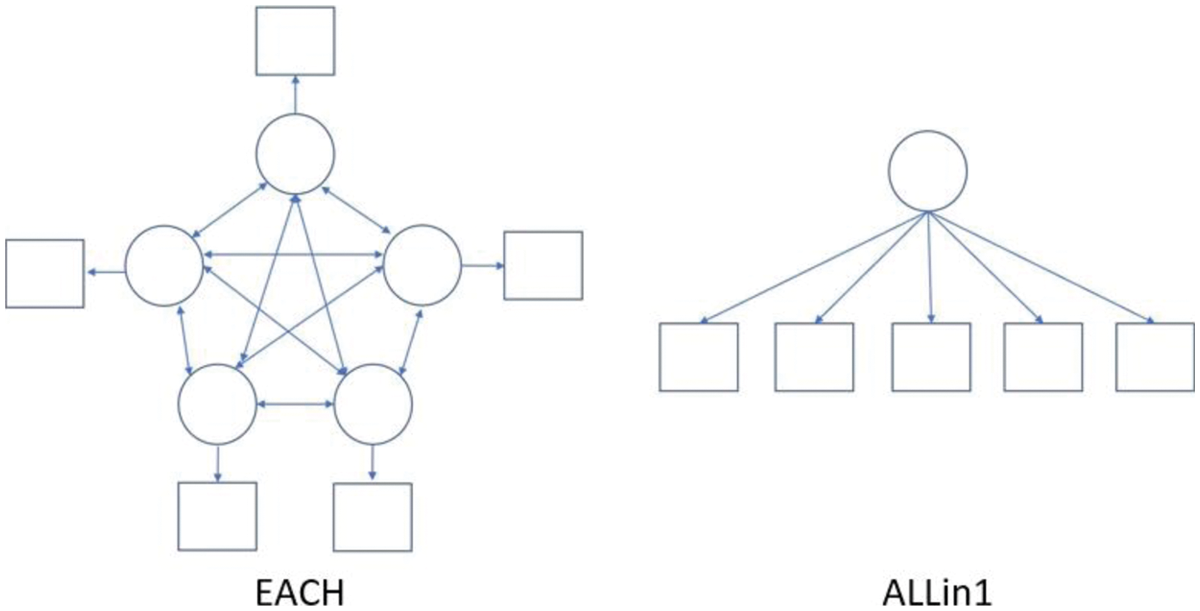
Figure 1: The example of diagrams of the options EACH and ALLin1 with five indicators. The circles represent the latent variables and the square represent indicator variables
When a model of the fuzzy clusterwise GSCA with covariates is fitted, the additional three arguments are required:
• covnames: A character vector. The names of columns of the dataset that indicate covariates in the model fitted.
• cov.model: A numeric vector. It is a vector of indicators of whether each covariate is used in specifying three sub-model in GSCA. The indicator is 1 if the covariate is involved in GSCA; and otherwise 0. Involving covariates in the GSCA model indicates that the covariates are used in defining the relation between indicators and latent variables.
• multinomial.ref: A character element. Options of MAX, MIN, FIRST, and LAST are available for setting a reference group. The default is MAX, which indicates that the class whose prevalence is the highest is used for a reference class in fitting a multinomial regression. Contrary, MIN indicates that the class whose prevalence is the lowest is used for a reference class. FIRST and LAST indicates that the first class and last class are used as the reference class, respectively.
In these arguments, there are kind of generic arguments such as dat, Boot.num, and multiple.Core that utilizes functions in R. On the other hand, ID.var, num.class, num.factor, covnames, cov.model, and multinomial.ref are unique functionalities associated with the gscaLCA package. Thus, a user considers what those values might be and needs to specify them to run gscaLCA.
The function gscaLCA returns an object involving many different elements. We have selected key features and recommend researchers to check all other arguments by using gscaLCA:
• N: The number of observations used after applying listwise deletion when missing values exist.
• N.origin: The number of observations before applying listwise deletion. This number is same as the number of observations of the input dataset.
• LEVELs: The observed categories for each indicator.
• all.levels.equal: The indicator whether all indicators used for analysis have the same answer categories. If it is FALSE, the program does not create a graph automatically.
• num.class: The number of classes used for the analysis.
• Boot.num: The number of bootstrap assigned by users.
• Boot.num.im: The number of bootstrap implemented. Not all iterations of bootstrap is needed to estimate the standard error.
• model.fit: The model fit indices. FIT, AFIT, FPI, and NCE are provided with the standard error and 95% credible interval lower and upper bounds.
• LCprevalence: The latent class prevalence. The percent of class, the number of observation for each class, standard error, and 95% credible interval lower and upper bounds are provided.
• RespProb: The item response probabilities for all variables used are reported as elements of a list. Each element consists of a table containing the probabilities with respect to the possible categories of each variable. The standard error and 95% credible interval with lower and upper bounds are also reported.
• it.in: The number of iteration of in-loop. The in-loop is used for the estimation of the GSCA model.
• it.out: The number of iteration of out-loop. The out-loop is used to update the membership probabilities of subjects.
• membership: A data frame of the posterior probability for each subject with the predicted class membership.
• plot: Graphs of item response probabilities within each category. For example, with two categories, each graph is stored as p1 and p2 in the list of plot. When the number of categories of indicators are different, the graphs are not provided.
• A.mat: The estimated factor loading matrix of the GSCA model.
• B.mat: The estimated path coefficient matrix of the GSCA model.
• W.mat: The estimated weighted relation matrix of the GSCA model.
• used.dat: The dataset that used for the analysis. When the input data include missing values, the data used are ones after applying listwise deletion.
When the covariates are involved in the analysis, the function gscaLCA returns eight additional elements:
• cov_results.multi.hard: This is the main result of the multinomial regression with the hard partitioning.
• cov_results_raw.multi.hard: This is the result of the multinomial regression with the hard partitioning, which is directly from the function nnet::multinom.
• cov_results.bin.hard: This is the main result of binominal regression with the hard partitioning.
• cov_results_raw.bin.hard: This is the result of the binominal regression with the hard partitioning, which is directly from the function stats::glm.
• cov_results.multi.soft: This is the main result of the multinomial regression with the soft partitioning.
• cov_results_raw.multi.soft: This is the result of the multinomial regression with the soft partitioning, which is directly from the function nnet::multinom.
• cov_results.bin.soft: This is the main result of binominal regression with the soft partitioning.
• cov_results_raw.bin.soft: This is the result of the binominal regression with the soft partitioning, which is directly from the function stats::glm.
4.4 gscaLCR Command Line and Options
In addition to the main function gscaLCA, the package gscaLCA provides a function which implements the second and third steps in the algorithm of fuzzy clusterwise GSCA with covariates (gscaLCR). The function is called gscaLCR. As aforementioned, fuzzy clusterwise GSCA with covariate includes three steps. Even if users fit the gscaLCA first without the covariates with the function gscaLCA, steps 2 and 3 of gscaLCR can be executed via the function gscaLCR.
R> gscaLCR(results.obj, covnames, multinomial.ref = "MAX")
The function gscaLCR requires three elements:
• results.obj: The result object of gscaLCA.
• covnames: A character vector of covariate names. The covariate variables have to be in the data that used to fit the gscaLCA model.
• multinomial.ref: A character element. Options of MAX, MIN, FIRST, and LAST are available for setting a reference group. The default is MAX.
The output of gscaLCR is the same as gscaLCA.
To demonstrate the usage of the package gscaLCA, we fit two analyses in gscaLCA with empirical exemplars: the one is fitting gscaLCA model without covariate, and the other is the one with covariates. The former is demonstrated with the TALIS data, and the latter is demonstrated with the AddHealth data. It should be noted that although the results of this study were obtained with methodological rigor, they would be slightly different from other researchers’ results within the TALIS study due to lurking variables.
5.1 An Example with gscaLCA without Covariate
For the TALIS data, we used the three-class model (num.class = 3) with a single factor (num.factor = "ALLin1"). It is the optimal model with these data that was found through the model comparison. Regarding the number of class, it is expected to have three factors, motivation, pedagogy, and satisfaction, as the variable name and explanation suggests (see Section 4.1.1). Regarding the number of factors, all variables are supposed to be explained by a common latent variable, because TALIS data is a survey data is collected from U.S. teachers with a topic of teaching and learning. The following command with the function gscaLCA was implemented to fit the fuzzy clusterwise GSCA. Once the gscaLCA command is executed, it displays the degree of the completion process as percentages while gscaLCA is running. When the estimation completes, the summary function is available to display the results. The summary function print out the sample size for the analysis, model fit indices, estimated latent class prevalence, and item response probabilities.
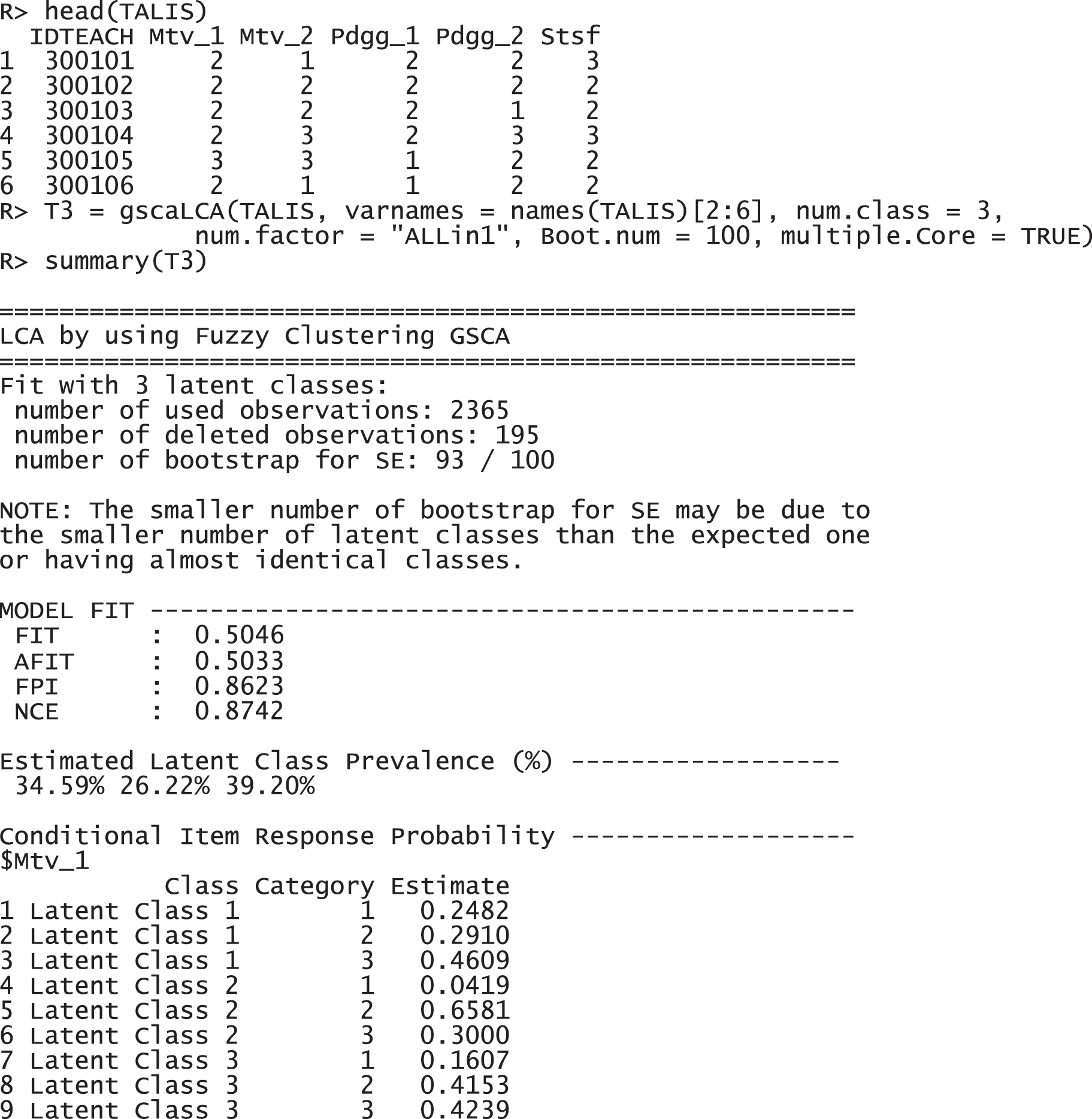
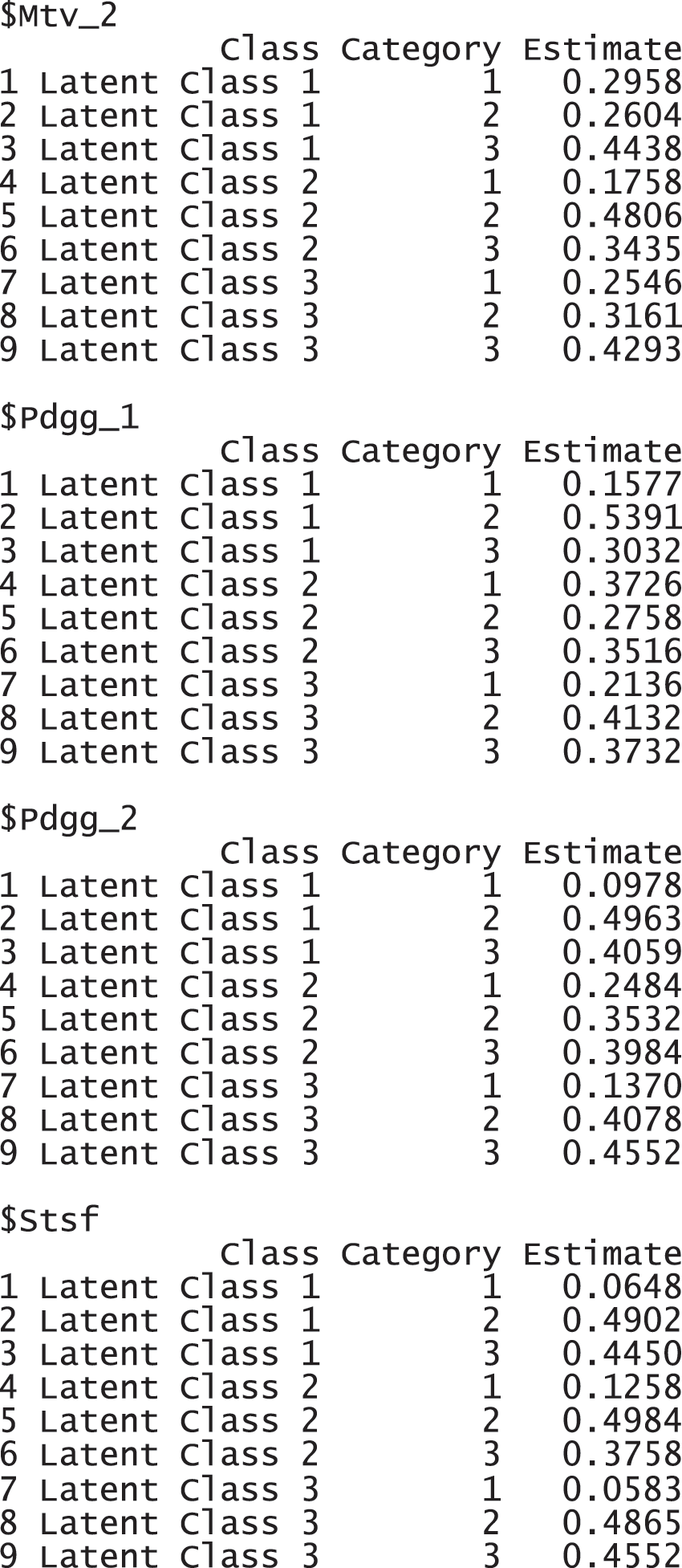
The results report that 2,365 observations were used for the analysis, excluding 195 incomplete responses. FIT and AFIT were 0.5046 and 0.5033, respectively. With a single factor, FIT and AFIT are typically lower than the larger number of factors. The indices to evaluate the classification were relatively large (FPI = 0.8623 and NCE = 0.8742), but they are better than when the option num.factor is EACH for these data. The estimated latent class prevalences is 34.59%, 26.22%, and 39.20%. The conditional item response probabilities for each category per variable are also presented in a table. When the standard error and 95% credible interval of the model fit, the prevalence and conditional response probabilities are required, we can print out the objects through the following commands. These standard error was estimated by the bootstrap.
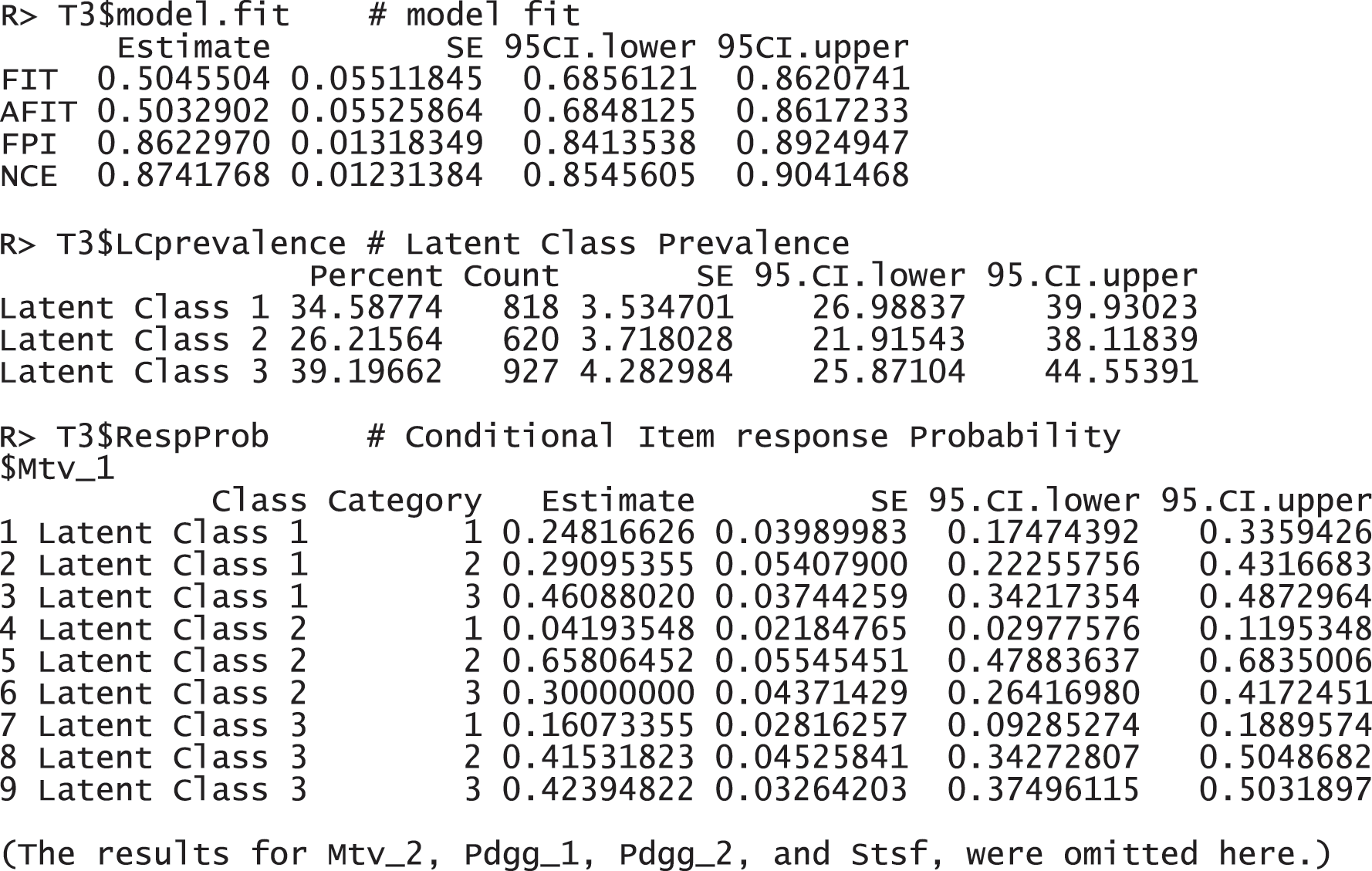
These response probabilities are used to define latent classes. In order to grasp the patterns of the probabilities, a visual representation of profiles based on the probabilities would be more helpful than numeric quantities in the output above. Once the gscaLCA function is executed, the graph is automatically created. When the command summary(T3) is executed, the resulting plot is displayed for all answer categories. When the plots for each answer category are required, it can also be printed by using the command T3$plot. Fig. 2 presents the conditional item response probabilities of the result, T3. Based on the patterns of responses in each class, we define “Pedagogy focused teachers”, “Motivated teachers”, and “Balanced teachers”. For example, for the second response, latent class 1 has relatively higher value in both Pdgg_1, and Pdgg_2 variables, but latent class 1 has relatively smaller value in other variables. Therefore, we define the first latent class as the “Pedagogy focused teachers”. For the second latent class, it has relatively higher value in both Mtv_1, and Mtv_2 variables, but has relatively smaller value in other variables. Therefore, we named the second latent class as the “Motivated teachers”. The third latent class has overall similar values across all five variables, thus, we called the third latent class as the “Balanced teschers”. Lastly, the membership probabilities of observations can be obtained from the membership of the saved objects, T3.


Figure 2: Profiles of three latent classes from fuzzy clusterwise GSCA by using TALIS data
5.2 An Example of gscaLCA with Covariates
In this example, we demonstrate how to fit the gscaLCA with covaritate by using the AddHealth data. We used the three-class model (num.class = 3) with num.factor = “EACH”. which was found in the previous research, Park et al. [10]. For this example, we considered 5 indicators (Smoking, Alcohol, Drug, Marijuana, and Cocaine) and the gender covariate. The gender covariate was involved in fitting the GSCA model (cov.model = 1). Adding the covariate into the GSCA model depends on researchers' decision in their fields, but we recommend to add the covariates into the GSCA model when the covarites affect not only the membership probabilities but also the relationship between indicators and latent variables. When multiple covariates are considered, the indicators of adding the covariates into the GSCA model are presented as a vector. For example, when researcher uses the second covariate out of three covariates in the GSCA model, the option cov.model with c(0, 1, 0) can be used. Fitting gscaLCA with covariates using the function gscaLCA produces the results as follows:
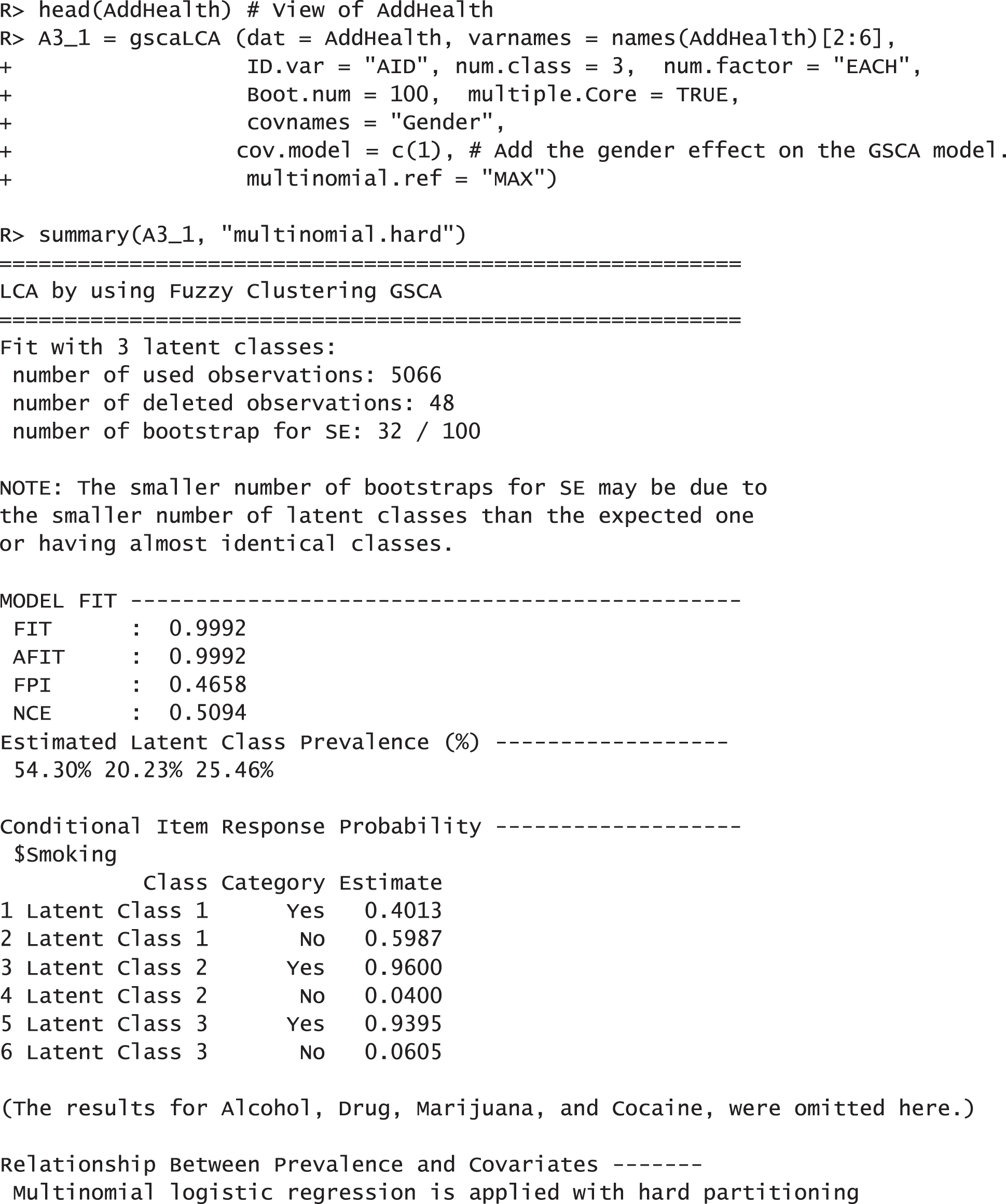
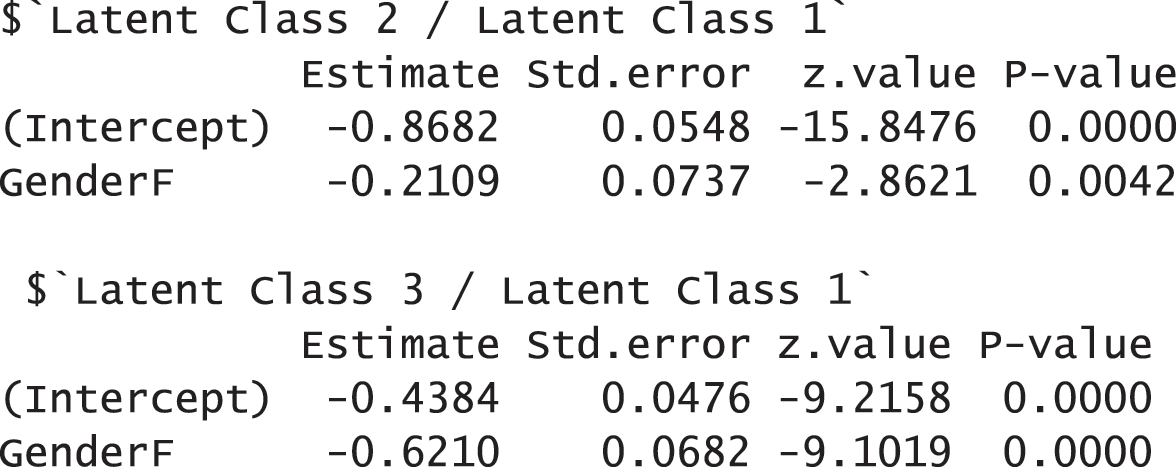
The results report that 5,065 observations were used for the analysis after applying the listwise deletion. They also show that the model fit indices with the AddHealth data are acceptable. FIT and AFIT were 0.9993 and 0.9993, and they are close to 1. The indices to evaluate the classification were relatively low (FPI = 0.4658 and NCE = 0.5094). The estimated latent class prevalences are 54.30%, 20.23%, and 25.46%. These estimated prevalences are changed depending on whether we consider covariates into a GSCA model or not. The conditional item response probabilities are also presented for each category per variable. Like the example of the TALIS data, the results here provide the 95% standard error by using the following commands:

When a category of response is binary, a graph provided by this package shows the probabilities’ patterns of each category. In the AddHealth data, thus the graph is involved when the response is “Yes”, because the responses are binary (Yes or No),
From the plot shown in Fig. 3, three latent class can be defined as “the smoking and drinking class (Latent Class 1)”, “the binge drinking and heavy smoking class (Latent Class 3)”, and “the heavy substance user class (Latent Class 2)” as previously shown in Park et al. [10]. For the case which needs the graphs for all categories of answers, plots for all categories are provided in the results of gscaLCA. Here, the outcome element of A3_1 contains the graphs for each response in plot. The graphs can be extracted by using the following two commands: the one for the category of “Yes” and the other for the category of “No”, respectively.
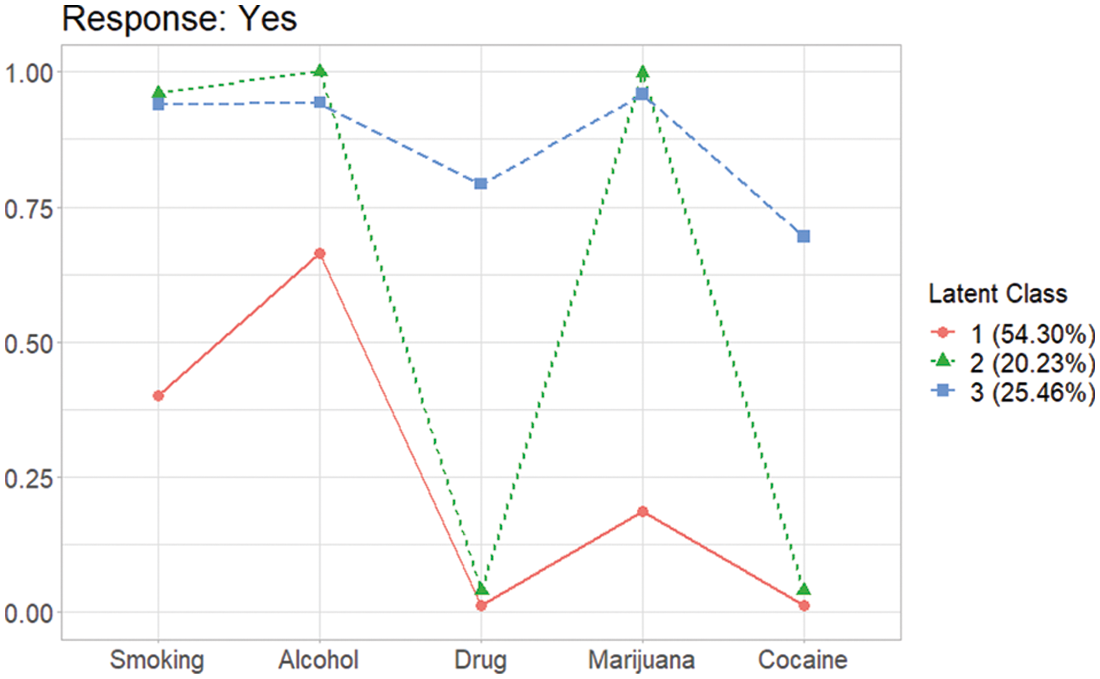
Figure 3: Profiles of three latent classes from fuzzy clusterwise GSCA in AddHealth data when the gender covariate is taken account into the GSCA model

To examine the effects of covariates on the membership probabilities, the function summary can be used as demonstrated before. Other options in partitioning and fitting regression (multinomial.soft, binomial.hard, and binomial.soft) are available as well in the function summary. In addition, the following command also provides the results of regressions:

As the example of A3_1, other options are available for hard and soft partitioning and multinomial and binomial regression.
Latent class analysis and clustering analysis including fuzzy clustering are statistical tools to identify (dis-)similarity of data distribution as a model-based mixture model and a data-driven classification approach, respectively. We developed the package, gscaLCA, in R that utilizes fuzzy clusterwise GSCA and fit class analysis with covariates as implemented in the other LCA or clustering analysis packages. Moreover, the gscaLCA package allows researchers to consider a structure of underlying constructs by utilizing the GSCA framework. This feature was unique and possible by utilizing least squares estimate. On the other hand, both methods, LCA and clustering analysis, have pros and cons but have been used in various fields at the selection of one of two methods based on researcher's discretion. Based on the theoretical foundation (Ryoo et al. [8]) with its efficiency in estimation, fuzzy clusterwise GSCA is now applicable to latent class analysis within the gscaLCA package, and its extension to latent class regression as a three-step approach is also available.
The gscaLCA package is still undergoing active development until it is equipped with as many mixture models as in the maximum likelihood-based structural equation modeling. Its next journey of gscaLCA is 1) to implement additional options on missing data such as multiple imputation [42], 2) to extend to multiple group and/or multilevel analysis [21], and 3) to extend gscaLCA to longitudinal data so as to fit latent transition analysis [21].
The R package, gscaLCA, provides a unified framework of fitting an LCA model utilizing fuzzy clustering algorithm and generalized structured component analysis. Both dichotomized observed variables and ordered categorical observed variables can be used in the function gscaLCA. In addition, visual representation of results profiles are a key feature in gscaLCA that helps researchers identify characteristics of classes. It should also be noted that the capacities of GSCA [9] within gscaLCA will extend the application of gscaLCA in a variety of SEM modeling.
Funding Statement: This research was supported by the Yonsei University Research Fund of 2021 (2021-22-0060).
Conflicts of Interest: The authors declare that they have no conflicts of interest to report regarding the present study.
1. Lazarsfeld, P. F. (1950). The logical and mathematical foundation of latent structure analysis. In: Studies in social psychology in World War II, vol. 4, pp. 362–412. Princeton, NJ: Princeton University Press. [Google Scholar]
2. McCutcheon, A. L. (1987). Latent class analysis. Thousand Oaks, California: Sage. [Google Scholar]
3. Dempster, A., Laird, N., Rubin, D. (1977). Maximum likelihood from incomplete data via the EM algorithm. Journal of the Royal Statistical Society, Series B (Methodological), 39(1), 1–22. DOI 10.1111/j.2517-6161.1977.tb01600.x. [Google Scholar] [CrossRef]
4. Gill, J., King, G. (2004). What to do when your hessian is not invertible: Alternatives to model respecification in nonlinear estimation. Sociological Methods & Research, 33(1), 54–87. DOI 10.1177/0049124103262681. [Google Scholar] [CrossRef]
5. Steinley, D., Brusco, M. J. (2011). Evaluating mixture modeling for clustering: Recommendations and cautions. Psychological Methods, 16(1), 63–79. DOI 10.1037/a0022673. [Google Scholar] [CrossRef]
6. Brusco, M. J., Shireman, E., Steinley, D. (2017). A comparison of latent class, K-means, and K-median methods for clustering dichotomous data. Psychological Methods, 22(3), 563–580. DOI 10.1037/met0000095. [Google Scholar] [CrossRef]
7. Lubke, G., Muthen, B. (2005). Investigating population heterogeneity with factor mixture models. Psychological Methods, 10(1), 21–39. DOI 10.1037/1082-989X.10.1.21. [Google Scholar] [CrossRef]
8. Ryoo, J. H., Park, S., Kim, S. (2020). Categorical latent variable modeling utilizing fuzzy clustering generalized structured component analysis as an alternative to latent class analysis. Behaviormetrika, 47(1), 291–306. DOI 10.1007/s41237-019-00084-6. [Google Scholar] [CrossRef]
9. Hwang, H., Takane, Y. (2014). Generalized structured component analysis: A component-based approach to structural equation modeling. Boca Raton: CRC Press. [Google Scholar]
10. Park, S., Kim, S., Ryoo, J. H. (2020). Latent class regression utilizing fuzzy clusterwise generalized structured component analysis. Mathematics, 8(11), 2076–2031. DOI 10.3390/math8112076. [Google Scholar] [CrossRef]
11. Ryoo, J. H., Park, S., Kim, S., Ryoo, H. S. (2020). Efficiency of cluster validity indexes in fuzzy clusterwise generalized structured component analysis. Symmetry, 12(9), 1514–1529. DOI 10.3390/sym12091514. [Google Scholar] [CrossRef]
12. Muthen, B., Muthen, L. (1998). Mplus user’s guide (eighth edition). Los Angeles, CA: Muthen & Muthen. [Google Scholar]
13. van Horn, M. L., Jaki, T., Masyn, K., Ramey, S. L., Smith, J. A. et al. (2009). Assessing differential effects: Applying regression mixture models to identify variations in the influence of family resources on academic achievement. Developmental Psychology, 45(5), 1298–1313. DOI 10.1037/a0016427. [Google Scholar] [CrossRef]
14. O’Neill, T. A., McLarnon, M. J. W., Xiu, L., Law, S. J. (2016). Core self-evaluations, perceptions of group potency, and job performance: The moderating role of individualism and collectivism cultural profiles. Journal of Occupational and Organizational Psychology, 89(3), 447–473. DOI 10.1111/joop.12135. [Google Scholar] [CrossRef]
15. Linzer, D. A., Lewis, J. B. (2011). PoLCA: An R package for polytomous variable latent class analysis. Journal of Statistical Software, 42(10), 1–29. DOI 10.18637/jss.v042.i10. [Google Scholar] [CrossRef]
16. Schreiber, J. B. (2017). Latent class analysis: An example for reporting results. Research in Social and Administrative Pharmacy, 13(6), 1196–1201. DOI 10.1016/j.sapharm.2016.11.011. [Google Scholar] [CrossRef]
17. Miranda, V. P. N., dos Santos Amorim, P. R., Bastos, R. R., Souza, V. G. B., de Faria, E. R. et al. (2019). Evaluation of lifestyle of female adolescents through latent class analysis approach. BMC Public Health, 19(1), 1–12. DOI 10.1186/s12889-019-6488-8. [Google Scholar] [CrossRef]
18. van Rijnsoever, F. J.,Castaldi, C. (2011). Extending consumer categorization based on innovativeness: Intentions and technology clusters in consumer electronics. Journal of the American Society for Information Science and Technology, 62(8), 1604–1613. DOI 10.1002/asi.21567. [Google Scholar] [CrossRef]
19. Xia, J., Evans, F. H., Spilsbury, K., Ciesielski, V., Arrowsmith, C. et al. (2010). Market segments based on the dominant movement patterns of tourists. Tourism Management, 31(4), 464–469. DOI 10.1016/j.tourman.2009.04.013. [Google Scholar] [CrossRef]
20. Lanza, S. T., Dziak, J. J., Huang, L., Wagner, A., Collins, L. M. (2015). PROC LCA & PROC LTA users’ guide version 1.3.2. State College, PA: The Methodology Center. [Google Scholar]
21. Collins, L. M., Lanza, S. T. (2009). Latent class and latent transition analysis: With applications in the social behavioral, and health sciences, vol. 718. Hoboken, NJ: John Wiley & Sons. [Google Scholar]
22. Reynolds, G. L., Fisher, D. G. (2019). A latent class analysis of alcohol and drug use immediately before or during sex among women. The American Journal of Drug and Alcohol Abuse, 45(2), 179–188. DOI 10.1080/00952990.2018.1528266. [Google Scholar] [CrossRef]
23. Ryoo, J. H., Wang, C., Swearer, S. M., Park, S. (2017). Investigation of transitions in bullying/victimization statuses of gifted and general education students. Exceptional Children, 83(4), 396–411. DOI 10.1177/0014402917698500. [Google Scholar] [CrossRef]
24. Hwang, H., Takane, Y., Jung, K. (2017). Generalized structured component analysis with uniqueness terms for accommodating measurement error. Frontiers in Psychology, 8, 2137–2148. DOI 10.3389/fpsyg.2017.02137. [Google Scholar] [CrossRef]
25. Widaman, K. F. (2007). Common factors versus components: Principals and principles, errors and misconceptions. In: Cudeck, R., MacCallum, R. C. (Eds.Factor analysis at 100: Historical developments and future directions, pp. 177–203. Mahwah, NJ: Lawrence Erlbaum Associates Publishers. [Google Scholar]
26. Bezdek, J. C. (1981). Pattern recognition with fuzzy objective function algorithms; advanced applications in pattern recognition. New York, NY: Plenum Press. [Google Scholar]
27. Mahata, K., Sarkar, A., Das, R., Das, S. (2017). Fuzzy evaluated quantum cellular automata approach for watershed image analysis. In: Bhattacharyya, S., Maulik, U., Dutta, P. (Eds.Quantum inspired computational intelligence, pp. 259–284. Boston, MA: Morgan Kaufmann. [Google Scholar]
28. Hastie, T., Tibshirani, R., Friedman, J. (2009). The elements of statistical learning: Data mining, inference, and prediction. New York, NY: Springer. [Google Scholar]
29. Mulaik, S. (2009). Foundations of factor analysis (2nd edition). Boca Raton: CRC Press. [Google Scholar]
30. Hwang, H., Desarbo, W. S., Takane, Y. (2007). Fuzzy clusterwise generalized structured component analysis. Psychometrika, 72(2), 181–198. DOI 10.1007/s11336-005-1314-x. [Google Scholar] [CrossRef]
31. Bollen, K. A., Curran, P. J. (2006). Latent curve models: A structural equation perspective. Hoboken, NJ: John Wiley & Sons. [Google Scholar]
32. Young, F. W. (1981). Quantitative analysis of qualitative data. Psychometrika, 46(4), 357–388. DOI 10.1007/BF02293796. [Google Scholar] [CrossRef]
33. Efron, E. (1979). Bootstrap methods: Another look at the jackknife. New York, NY: Springer. [Google Scholar]
34. Roubens, M. (1982). Fuzzy clustering algorithms and their cluster validity. European Journal of Operational Research, 10(3), 294–301. DOI 10.1016/0377-2217(82)90228-4. [Google Scholar] [CrossRef]
35. Vermunt, J. K. (2010). Latent class modeling with covariates: Two improved three-step approaches. Political Analysis, 18(4), 450–469. DOI 10.1093/pan/mpq025. [Google Scholar] [CrossRef]
36. Vermunt, J. K. (1997). LEM: A general program for the analysis of categorical data. Netherlands: Department of Methodology and Statistics, Tilburg University. [Google Scholar]
37. Yamaguchi, K. (2000). Multinomial logit latent-class regression models: An analysis of the predictors of gender-role attitudes among Japanese women. American Journal of Sociology, 105(6), 1702–1740. DOI 10.1086/210470. [Google Scholar] [CrossRef]
38. Bolck, A., Croon, M., Hagenaars, J. (2004). Estimating latent structure models with categorical variables: One-step versus three-step estimators. Political Analysis, 12(1), 3–27. DOI 10.1093/pan/mph001. [Google Scholar] [CrossRef]
39. OECD (2019). Teachers and school leaders as lifelong learners. In: TALIS, 2018 results, vol. 1. Paris: OECD Publishing. [Google Scholar]
40. Dias, J. G., Vermunt, J. K. (2008). A bootstrap-based aggregate classifier for model-based clustering. Computational Statistics, 23(4), 643–659. DOI 10.1007/s00180-007-0103-7. [Google Scholar] [CrossRef]
41. Harris, K. M., Halpern, C. T., Whitsel, E., Hussey, J., Tabor, J. et al. (2009). The national longitudinal study of adolescent to adult health. Chapel Hill, NC: Carolina Population Center. [Google Scholar]
42. Rubin, D. B. (2004). Multiple imputation for nonresponse in surveys. Hoboken, NJ: John Wiley & Sons. [Google Scholar]
 | This work is licensed under a Creative Commons Attribution 4.0 International License, which permits unrestricted use, distribution, and reproduction in any medium, provided the original work is properly cited. |